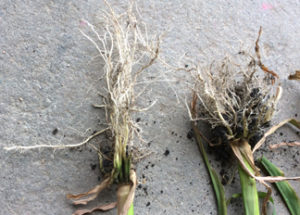
Prepare to Manage Sidewall Compaction Now to Protect Yield Potential at Planting Time
The 2017 growing season saw growers facing many yield robbing factors but an extremely common issue was sidewall compaction. Sidewall compaction occurs when the soil structure of the seed trench has been compromised and tightly compacted due to a combination of mechanical pressure and field moisture.
Corn has a fibrous root structure. This makes it highly susceptible to sidewall compaction. Restrictions on root growth will have season long impacts on the corn plant. This can seriously reduce yield potential as a result. Springs that are wet followed by summers that are exceptionally dry are much more likely to see the yield robbing power of sidewall compaction. Planting into wet conditions are the number one cause of sidewall compaction. The water acts like lubricant for soil particles and helps to pack them together. The compaction zone becomes increasingly hard as the season progresses and becomes drier. As a result, the plants access to necessary water and nutrients is restricted. Managing sidewall compaction from the beginning is an important step in maintain high yield potential in your corn crop.
Little Things Add Up
These tips can help reduce sidewall compaction on your farm for the 2018 season.
Wait to plant – Wet conditions are the number one cause of soil compaction! Wait for drier conditions to plant as much as possible. One grower in 2017 saw a 40 bu/ac yield difference with the same hybrid between two planting dates only 2 days apart.
Reduce down-pressure in damp conditions – Sometimes you just have to plant in fields that are a little too damp. When this happens reduce the down-pressure. This will help reduce the force pushing the soil particles together.
Avoid planting too shallow – Most corn planters are designed for corn to be planted at 2-3 inches below the soil surface. Angled press wheels have imaginary lines that intersect around this depth. Properly closing the seed trench is designed to help fracture minor sidewall compaction.
Reduce unnecessary tillage – Unnecessary or excess tillage can destroy the natural structure of the soil. Soil without a structure is more susceptible to compaction of all kinds.
Consider spoked closing wheels – Many companies create spoked closing wheels that are designed to fracture sidewall compaction. Some growers implement one spoked wheel and one standard wheel and some change both closing wheels to those designed with spokes.
